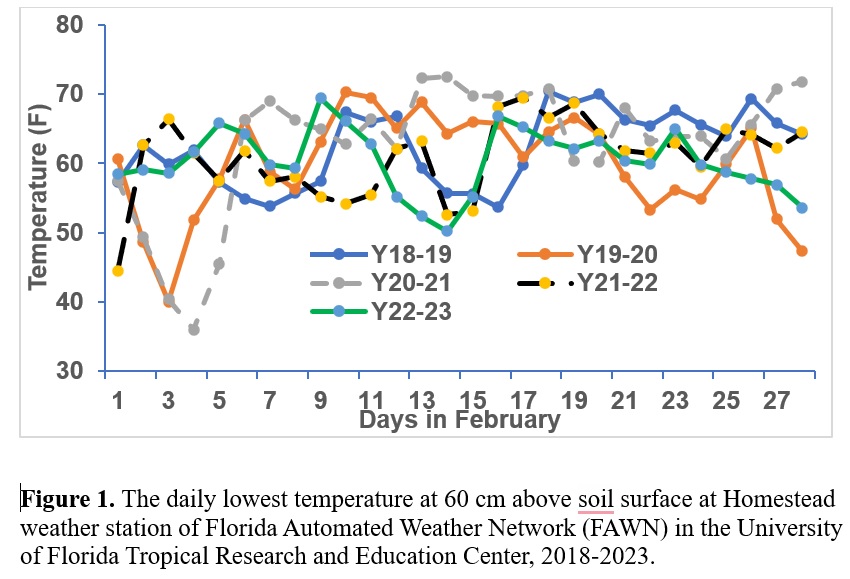Qingchun Liu, Teresa Olczyk, and Jianjun Chen
Miami-Dade County is the top producer of ornamental crops in Florida, with a total value of around 700 million in 2017. Most ornamental crops are subtropical and tropical in origin and sensitive to temperatures below 50 °F (10 °C), particularly to temperatures near freezing points during winter months. In Miami-Dade County, winter temperatures rarely drop to below freezing temperatures. However, temperatures below 50 °F but above or close to the freezing point can occur, which could cause chilling injury on sensitive plants, especially those tropical foliage plants, such as Aglaonema and Dieffenbachia.
Chilling injury often leads to sunken pits on leaves, leaf wilting with water-soaked spots or entire leaves, reduced growth or sprouting capability, and necrosis due to following warm temperatures. Such symptoms can substantially reduce the aesthetic value of ornamental plants. This publication is intended to provide nursery growers with information on when they need to pay attention to cold weather and corresponding measures to mitigate injury to ornamental plants from low temperatures.
Characteristics of local winter weather
During the last five years, from 2018 to 2023, the month of January had an average of 2.8 (2-4) cold events each year, followed by December, February, and November with 1.8 (1-3), 0.8 (0-2), and 0.4 (0-1) cold events, respectively. The lowest temperature occurred in the month of January in 3 out of 5 winters, and they were close to the freezing point in the last two winters. December had the lowest temperature in only one winter, 2019-2020. The average days with temperatures lower than 50 °F over the five winters were 8 (5-11), 4 (1-7), 1.6 (0-3), and 0.6 (0-2) in the months of January, December, February, and November, respectively. Among the 29 cold events in the five winters, only 2 of them had the lowest temperatures reached close to the freezing point (lower than 35 °F), and one of them occurred in the month of February 2021.
Passive cold protection
In Miami-Dade County, most ornamental plants are grown in shade houses or open fields. Preventive methods may be more practical for protecting plants from chilling injury, which include site management of cold air drainage, plant selection and management, plant nutrition, irrigation management, and weather monitoring.
Site management. Cold events are often associated with wind. Damage to the plants during such cold events is directional, usually located on the west and north sides of the production area. Having tall plantings and fences at the west and north sides of the shade houses and fields may help mitigate the damage to plants from cold events like advective freezes. However, leaving certain entryways within those plantings may help improve air drainage through nursery crops and prevent cold air from settling down.
Plant selection and their management. Plant selection and their management, particularly fertilizer management, are critical in mitigating damage to plants from low temperatures. Shipping the most susceptible plants before the chilling event, usually before the Thanksgiving holiday, would be a good choice to avoid losses. Due to the relatively long growing period, particularly for foliage plants, chilling temperatures cannot be avoided. Selecting cultivars that are tolerant to low temperatures if available, would be the best choice as there are significant differences in chill sensitivity among genera and even cultivars.
Hardy or cold-acclimated plants can improve plant tolerance to cold weather. Limiting the new growth in the late fall, October to November, through the reduction of fertilizer amount to two-thirds of the standard rate in south Florida, or even avoiding nitrogen application, may help acclimate the plants to low temperatures. In addition, the application of silicon may help enhance chilling resistance for ornamental plants.
Low-temperature monitoring and overhead irrigation. Close-to-freezing point temperatures did occasionally occur in Miami-Dade County though it may only last for a few hours. When a very cold event is certain to affect the area, turning on the overhead sprinklers to provide adequate water to maintain a film of liquid water on the foliage surfaces; otherwise, more severe damage will be incurred than no cold protection through irrigation at all. In addition, watering plants to field or container capacity during the day before such a cold event can help protect the plants by increasing heat absorption and storage.
It is also critical to monitor the night temperature when near-freezing temperatures are forecasted, which will help make an onsite decision whether or not to turn on the overhead irrigation, as such freezing temperatures usually occur from midnight to early morning hours. Irrigation is valuable tool to save ornamental plants whenever such a near-freezing cold event is to happen. Growers can monitor the temperature in their nurseries using a thermometer or by accessing the weather data at the Homestead weather station of FAWN. When the temperature drops to a critical point, start the overhead irrigation, and turn off the irrigation after the air temperature is stable above 35 °F.
When will there be no more chilling weather? Over the last five years (2019-2022), temperatures stably stay above 50 °F appeared to be after the first 7-10 days in February in Miami-Dade County (Fig. 1). There will be no concern of damage from chilling temperatures, and growers can start their normal production protocol to meet their shipping dates of specific ornamental crops.
In summary, nursery growers in Miami-Dade County need to watch for low temperatures from late December through early February. It is very important to prepare plants to acclimate to chilling temperatures. When it is certain that a nighttime temperature could drop to the freezing level, turning on overhead irrigation could help mitigate injuries to ornamental plants.
 0
0

